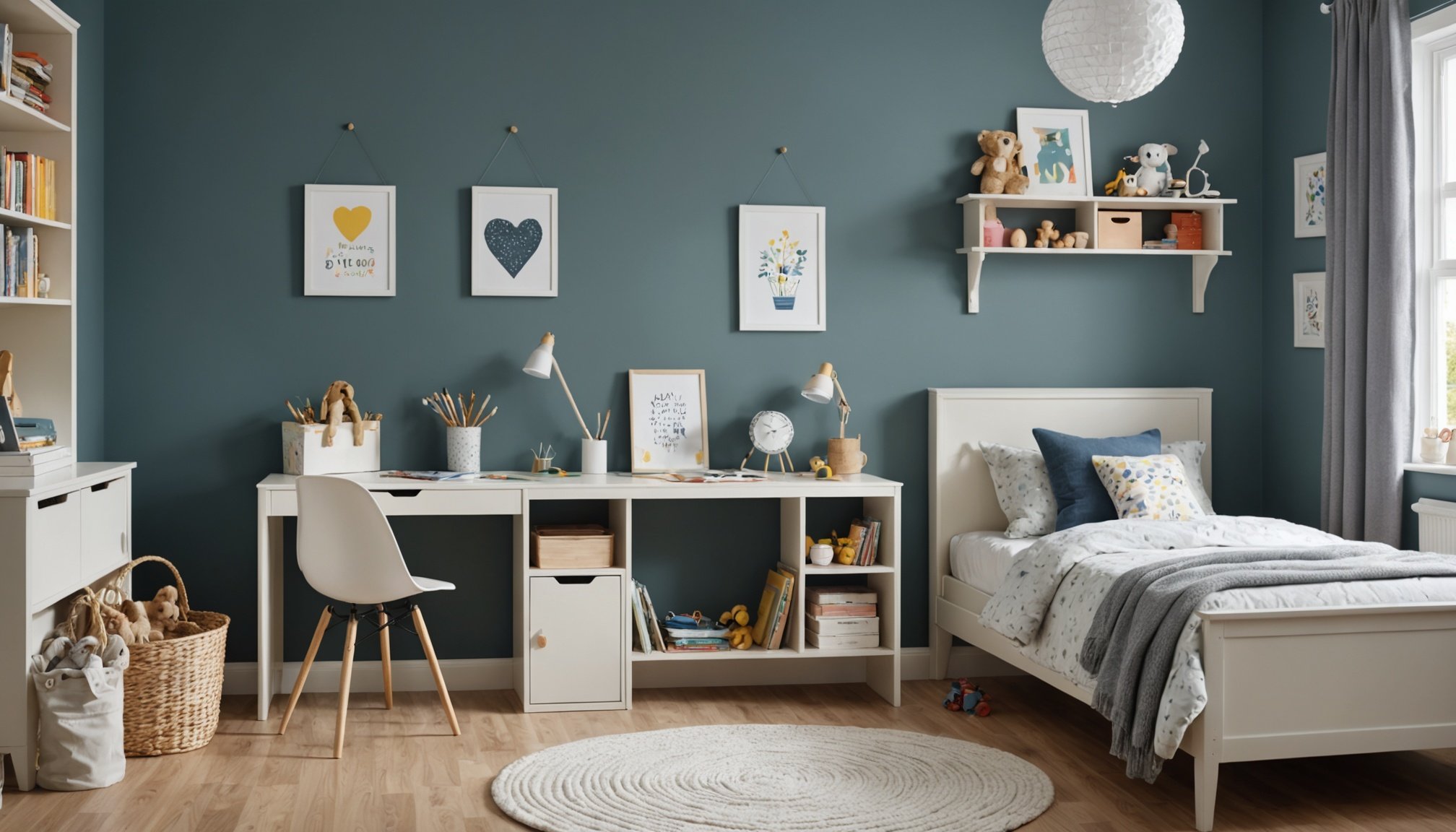Understanding Kid-Safe Paints
When selecting kid-safe paints, it’s crucial to prioritize non-toxic paint options. Essentially, these paints are formulated without harmful chemicals, making them safe for children who might come into contact with the painted surfaces. Traditional paints often contain volatile organic compounds (VOCs), formaldehyde, and heavy metals, which can emit fumes long after application. These substances can pose various health risks, from mild irritations to more severe respiratory issues.
In contrast, non-toxic paint options are designed to be free of such harmful ingredients. They are manufactured using water-based formulas, significantly reducing any potential health hazards. Choosing child-friendly paint ensures that indoor air quality remains safe for young children, who are more susceptible to the effects of chemicals due to their developing immune systems.
A découvrir également : Surrey's top floor cleaning services: shine restoration & surface care
Parents can create a safe environment by selecting paints labelled as low-VOC, zero-VOC, or made with natural ingredients. The benefits of these paints extend beyond health, providing peace of mind that children are safe from harmful exposures. Plus, these paints are durable and available in an array of vibrant colours, perfect for expressive and imaginative spaces tailored for kids.
Types of Kid-Safe Paints
When it comes to safeguarding your child’s environment, choosing types of non-toxic paint is essential. Three popular types include VOC-free paint, eco-friendly paint, and non-toxic varieties specifically designed to limit harmful exposure.
A lire en complément : Essential Tips for Preserving Your Slate Roof in a Picturesque Welsh Village
Water-Based Paints
Water-based paints are a prominent choice due to their low emission of volatile organic compounds (VOCs), making them a reliable VOC-free paint option. Their water-soluble nature means they are easy to clean and generally dry faster. These paints are known for their eco-friendly paint characteristics, offering a safer alternative for households with children. The durability is admirable, providing a smooth finish with minimal odour. Notable brands include Benjamin Moore Aura and Sherwin-Williams Harmony.
Chalk Paints
Chalk paints are celebrated for their non-toxic formulation and ease of application. They offer a unique matte finish and do not require extensive surface preparation. Their composition, often free of harmful chemicals, enhances their appeal as economically friendly choices. Despite being less durable compared to traditional paints, they provide an alluring vintage finish. Annie Sloan and Rust-Oleum are recommended brands in this category.
Milk Paints
Derived from natural ingredients, milk paints present themselves as the epitome of non-toxic and eco-friendly options. They provide a rich, textured finish and are particularly robust on wood surfaces. The absence of synthetic chemicals enhances their suitability in nurseries and playrooms. Popular brands include Real Milk Paint Co. and Old Fashioned Milk Paint.
Safety Certifications for Paints
Navigating the world of paints in the UK involves understanding various safety standards and certification labels. These markers are integral in ascertaining the safety and eco-friendliness of products. Safety certifications work as a promise to consumers that the products they use are devoid of harmful components and meet rigorous standards.
In the UK, EN71 standards are prominent, particularly for paints used on toys. EN71 ensures that materials used in children’s products are non-toxic and safe for little ones. Meanwhile, the EU Ecolabel is a trusted marker for environmentally friendly products. This certification indicates that the product has a reduced environmental impact throughout its lifecycle—an appealing prospect for eco-conscious consumers.
Certification labels are not merely decorative. They are crucial in maintaining consumer safety and confidence. An endorsed label means a product has been rigorously tested and verified, reducing potential health risks associated with certain paints. Moreover, these labels also encourage manufacturers to produce safer, eco-friendlier options, creating a positive cycle of environmental responsibility and consumer satisfaction. Understanding these safety standards is a vital step in making informed decisions about which products to choose, especially for those prioritising health and sustainability.
Application Tips for Kid-Safe Paints
Before embarking on a painting project, it’s crucial to understand some effective painting tips and preparation techniques for using kid-safe paints.
Surface Preparation
Begin by thoroughly cleaning the area to be painted. This ensures the paint adheres properly, resulting in a smoother finish. Remove dust and grease with a mild soap and water solution, then dry the surface completely to avoid any moisture issues. If dealing with glossy surfaces, lightly sand them for better adherence of the paint, enhancing its durability and overall appearance.
Tools and Equipment
To achieve optimal results, invest in high-quality tools. Use fine-bristle brushes or rollers specific to the paint being used to minimize brush marks. Ensure that tools are well-maintained and clean before use, preventing any contamination that could affect the paint’s performance.
Safe Application Practices
When applying kid-safe paints, prioritize ventilation to reduce fumes. Keep windows open and use fans if possible to improve airflow and minimize inhalation risks. Wear protective gear such as gloves and masks to safeguard skin and respiratory health. Follow label instructions regarding dry times and coats to avoid over-application, ensuring a safe environment throughout the painting process.
Environmental Considerations
Understanding the environmental impact of traditional paints is crucial. These paints often contain volatile organic compounds (VOCs) that can release harmful chemicals into the air. This not only contributes to air pollution but can also lead to serious health issues for those exposed over time.
Switching to eco-friendly paints offers a range of benefits. These paints are formulated with reduced levels of VOCs or are entirely VOC-free, making them a healthier choice for indoor environments. Additionally, eco-friendly paints use natural pigments and ingredients, which are less harmful to both the environment and human health.
Adopting green painting practices extends beyond the paint itself to the entire process, including energy-efficient methods and responsible disposal. Opt for energy-saving tools and equipment that minimize electricity use during application. After completing a project, ensure proper disposal or recycling of paint containers to reduce landfill waste.
Incorporating sustainable methods in your painting approach not only benefits the environment but also improves indoor air quality, creating a healthier living space. In doing so, individuals and businesses can contribute to a more sustainable future while still achieving their aesthetic goals.
Popular Kid-Safe Paint Brands in the UK
Exploring kid-safe paint brands is crucial for any family concerned about health and safety. With numerous options, it’s often challenging to pinpoint the best non-toxic paints. Here, we dive into brands renowned for their natural and safe formulations, thoroughly explored through user experiences and expert reviews.
Brand Comparisons
In the UK, several brands stand out. Little Greene is highly favoured for its eco-friendly ingredients, ensuring minimal harmful emissions. Similarly, Earthborn is celebrated for its clay-based paints, perfect for those requiring additional breathability. Each brand consistently receives praise for their innovative approaches and environmental commitment.
User Ratings and Testimonials
The reviews of paint brands commonly highlight key qualities. Little Greene is frequently praised for its vibrant hues and durability, boasting an average customer rating of 4.8 out of 5. Users of Earthborn commend its smooth application and subtle finish, with testimonials often featuring words like “transformative” and “trusted.”
Price Comparisons
Price varies across these kid-safe paint brands. Little Greene typically offers premium pricing reflective of its quality, while Earthborn positions itself more accessibly to cater to wider budgets. Whether seeking luxury or affordability, there’s a suitable option within the UK market for best non-toxic paints.
Buying Guide for Kid-Safe Paints
Selecting the right kid-safe paints is crucial for ensuring the safety and health of children during painting activities. There are several factors to consider when making your decision. First, evaluate the paint’s composition: avoid harmful chemicals like volatile organic compounds (VOCs), which can be hazardous. Opt for non-toxic, water-based paints that are labelled as child-friendly and environmentally safe.
When comparing products, check for certifications and labels from reputable safety standards organisations. These endorsements ensure that the paint meets rigorous safety criteria. Additionally, consider the durability and washability of the paint, especially if it’s to be used on surfaces accessible to children, ensuring it can withstand wear and tear.
For making informed purchasing decisions, researching and reading reviews and recommendations from other parents can be invaluable. Online platforms provide a wealth of information and experiences shared by other buyers, helping you gauge product effectiveness and safety. You might also want to visit physical stores to get a closer look at available options.
When looking for resources to purchase, check both online marketplaces and local retailers for a variety of choices. This broadens your selection and might offer better prices or exclusive products.
Visual Inspiration and Decor Integration
Incorporating colourful decor ideas in a children’s bedroom can be both fun and rewarding. The key lies in choosing the right theme that reflects the child’s interests. For instance, a space-themed room can come alive with deep blue walls painted with stars and planets, or consider an under-the-sea theme using shades of aqua and coral. Painting inspiration can also spring from a child’s favourite storybook or cartoon character, making the room a personal haven.
When considering paint, accent walls are a great way to introduce a pop of colour or a unique pattern. Techniques such as stripes, polka dots, or even a custom mural can create a vibrant environment. Try using complementary colours to create a cohesive look while still being playful. For example, a jungle theme might incorporate greens and yellows, using wall stickers or stencils for added detail.
Real-life examples abound: think of a room where one wall is a giant chalkboard for creativity, or where soft pastel hues create a serene atmosphere for rest. Wall decals and removable wallpaper can also add a dynamic layer to the design, allowing flexibility as a child grows and their tastes evolve.











